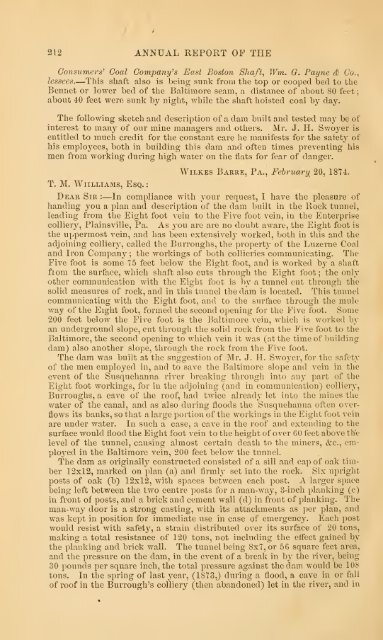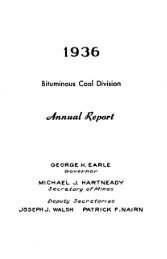1873 - Old Forge Coal Mines
1873 - Old Forge Coal Mines
1873 - Old Forge Coal Mines
You also want an ePaper? Increase the reach of your titles
YUMPU automatically turns print PDFs into web optimized ePapers that Google loves.
212 ANNUAL REPORT OF THE<br />
Consumers? Goal Company's East Boston Shaft, Wm. G. Payne & Co.,<br />
lessees.—This shaft also is being sunk from the top or cooped bed to the<br />
Bennet or lower bed of the Baltimore seam, a distance of about 80 feet<br />
about 40 feet were sunk by night, while the shaft hoisted coal by day.<br />
The following sketch and description of a dam built and tested may be of<br />
interest to many of our mine managers and others. Mr. J. H. Swoyer is<br />
entitled to much credit for the constant care he manifests for the safet} T of<br />
his employees, both in building this dam and often times preventing his<br />
men from working during high water on the flats for fear of danger.<br />
Wilkes Barre, Pa., February 20, 1814.<br />
T. M. Wiilliams, Esq. :<br />
Dear Sir :—In compliance with your request, I have the pleasure' of<br />
handing you a plan and description of the dam built in the Rock tunnel,<br />
leading from the Eight foot vein to the Five foot vein, in the Enterprise<br />
colliery, Plainsville, Pa. As you are are no doubt aware, the Eight foot is<br />
the uppermost vein, and has been extensively worked, both in this and the<br />
adjoining colliery, called the Burroughs, the propert}- of the Luzerne <strong>Coal</strong><br />
and Iron Company ; the workings of both collieries communicating. The<br />
Five foot is some 75 feet below the Eight foot, and is worked by a shaft<br />
fiom the surface, which shaft also cuts through the Eight foot ; the only<br />
other communication with the Eight foot is by a tunnel cut through the<br />
solid measures of rock, and in this tunnel the dam is located. This tunnel<br />
communicating with the Eight foot, and to the surface through the mule<br />
way of the Eight foot, formed the second opening for the Five foot. Some<br />
200 feet below the Five foot is the Baltimore vein, which is worked by<br />
an underground slope, cut through the solid rock from the Five foot to the<br />
Baltimore, the second opening to which vein it was (at the time of building<br />
dam) also another slope, through the 1'ock from the Five foot.<br />
The dam was built at the suggestion of Mr. J. H. Swojer, for the safety<br />
of the men employed in, and to save the Baltimore slope and vein in the<br />
event of the Susquehanna river breaking through into any part of the<br />
Eight foot workings, for in the adjoining (and in communication) colliery,<br />
Burroughs, a cave of the roof, had twice already let into the mines the<br />
water of the canal, and as also during floods the Susquehanna often overflows<br />
its banks, so that a large portion of the workings in the Eight foot vein<br />
are under water. In such a case, a cave in the roof and extending to the<br />
surface would flood the Eight foot vein to the height of over 60 feet above the<br />
level of the tunnel, causing almost certain death to the miners, &c, employed<br />
in the Baltimore vein, 200 feet below the tunnel.<br />
The dam as originally constructed consisted of a sill and cap of oak timber<br />
12x12, marked on plan (a) and firmly set into the rock. Six upright<br />
posts of oak (b) 12x12, with spaces between each post. A larger space<br />
being left between the two centre posts for a man-way, 3-inch planking (c)<br />
in front of posts, and a brick and cement wall (d) in front of planking. The<br />
man-way door is a strong casting, with its attachments as per plan, and<br />
was kept in position for immediate use in case of emergency. Each post<br />
would resist with safety, a strain distributed over its surface of 20 tons,<br />
making a total resistance of 120 tons, not including the effect gained by<br />
the planking and brick wall. The tunnel being 8x7, or 56 square feet area,<br />
and the pressure on the dam, in the event of a break in by the river, being<br />
30 pounds per square inch, the total pressure against the dam would be 108<br />
tons. In the spring of last year, (<strong>1873</strong>,) during a flood, a cave in or fall<br />
of roof in the Burrough's colliery (then abandoned) let in the river, and in




![1945 Anthracite Annual Report Districts 19 - 25 [Adobe pdf - 9148Kb]](https://img.yumpu.com/50308099/1/190x119/1945-anthracite-annual-report-districts-19-25-adobe-pdf-9148kb.jpg?quality=85)


![1937 Anthracite Annual Report Districts 1 - 11 [Adobe pdf - 9394Kb]](https://img.yumpu.com/43539962/1/190x119/1937-anthracite-annual-report-districts-1-11-adobe-pdf-9394kb.jpg?quality=85)






![1931 Anthracite Annual Report Districts 1 - 11 [Adobe pdf - 8007Kb]](https://img.yumpu.com/39427789/1/190x119/1931-anthracite-annual-report-districts-1-11-adobe-pdf-8007kb.jpg?quality=85)

